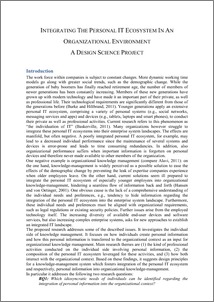|
Integrating the Personal IT Ecosystem in an Organizational Environment - A Design Science Project
Gaß, Oliver
![[img]](https://madoc.bib.uni-mannheim.de/style/images/fileicons/application_pdf.png)  Vorschau |
|
PDF
DESRIST_DoctoralConsortium_HighRes.pdf
- Veröffentlichte Version
Download (626kB)
|
|
URL:
|
https://ub-madoc.bib.uni-mannheim.de/31688
|
|
URN:
|
urn:nbn:de:bsz:180-madoc-316882
|
|
Dokumenttyp:
|
Arbeitspapier
|
|
Erscheinungsjahr:
|
2012
|
|
Ort der Veröffentlichung:
|
Mannheim
|
|
Sprache der Veröffentlichung:
|
Englisch
|
|
Einrichtung:
|
Fakultät für Betriebswirtschaftslehre > Wirtschaftsinformatik IV (Mädche 2009-2015)
|
|
Fachgebiet:
|
330 Wirtschaft
|
|
Abstract:
|
The work force within companies is subject to constant changes. More dynamic working time
models go along with greater social trends, such as the demographic change. While the
generation of baby boomers has finally reached retirement age, the number of members of
newer generations has been constantly increasing. Members of these new generations have grown up with modern technology and have made it an important part of their private, as well as professional life. Their technological requirements are significantly different from those of
the generations before (Burke and Hiltbrand, 2011). Younger generations apply an extensive
personal IT ecosystem, comprising a variety of personal systems (e.g., social networks,
messaging services and apps) and devices (e.g., tablets, laptops and smart phones), to conduct
their private as well as professional activities. Current research refers to this phenomenon as “the individuation of IT” (Baskerville, 2011). Many organizations however struggle to integrate these personal IT ecosystems into their enterprise system landscapes. The effects are manifold, but often negative. A poorly integrated personal IT ecosystem, for example, may lead to a decreased individual performance since the maintenance of several systems and
devices is error-prone and leads to time consuming redundancies. In addition, also
organizational performance suffers when important information is forgotten on personal
devices and therefore never made available to other members of the organization.
One negative example is organizational knowledge management (compare Alavi, 2011): on
the one hand, knowledge-management is widely perceived as a possible solution to ease the
effects of the demographic change by preventing the leak of expertise companies experience
when older employees leave. On the other hand, current solutions seem ill prepared to
integrate the personal IT ecosystem of especially younger employees into organizational
knowledge-management, hindering a seamless flow of information back and forth (Hansen
and von Oetinger, 2001). One obvious cause is the lack of a comprehensive understanding of
the individual needs and preferences, e.g., tendency to hide information regarding the
integration of the personal IT ecosystem into the enterprise system landscape. Furthermore,
these individual needs and preferences must be aligned with organizational requirements,
such as legal regulations or existing security policies. Further issues arise from the employed
technology itself. The increasing diversity of available end-user devices and software
services, but also increasing complex enterprise systems, asks for new approaches to establish
an integrated IT landscape.
The proposed research addresses
|
 | Dieser Eintrag ist Teil der Universitätsbibliographie. |
 | Das Dokument wird vom Publikationsserver der Universitätsbibliothek Mannheim bereitgestellt. |
 Suche Autoren in Suche Autoren in
BASE:
Gaß, Oliver
Google Scholar:
Gaß, Oliver
Sie haben einen Fehler gefunden? Teilen Sie uns Ihren Korrekturwunsch bitte hier mit: E-Mail
Actions (login required)
 |
Eintrag anzeigen |
|
|
